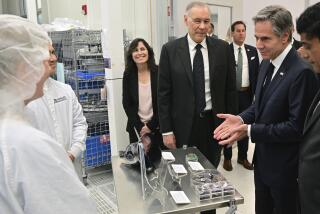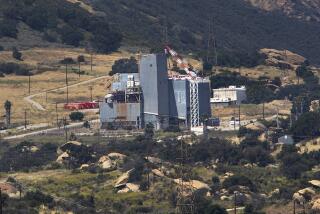IRT Plans Test Lab for ‘Star Wars’ Electronics
- Share via
SAN DIEGO — IRT Corp. plans to build the nation’s first privately owned laboratory to test whether “Star Wars” electronics devices can withstand exposure to nuclear radiation, company officials said Wednesday.
Nuclear survivability testing is now conducted at a small number of government facilities, including test sites in New Mexico, Maryland and Tennessee, according to Dennis Swift, president of IRT’s electronics systems group.
IRT’s proposed underground facility, to be built at the company’s San Diego headquarters, would use low-level sources of radiation to determine whether electronic devices would survive attack by neutrons or gamma rays, Swift said.
“We’ll be able to test for natural radiation in the space environment and for the effects of nuclear weapons burst,” he said, adding that the facility, which is expected to be in operation by February, would duplicate the extremely cold operating environment found in space.
Although IRT suggested that its facility would “test the ability of equipment to survive major nuclear radiation damage,” Swift described the testing facility’s radiation source as “low level.”
“The radiation source we’re using for gamma rays is not unlike what (a nearby hospital clinic) uses,” Swift said.
The company has applied for an amendment to a state license that allows it to store radioactive material used in its testing procedures.
Although IRT officials said the company would register its plans with appropriate government authorities, Jay Powell, a spokesman for the San Diego chapter of the Sierra Club, suggested that the addition of nuclear material “calls for more extensive environmental review.”
Some government facilities that test larger electronic systems use radiation generated by small nuclear generators, said a spokesman for the White Sands Missile Range in New Mexico, which operates a nuclear effects testing program capable of handling “whole vehicles and missiles.”
“The largest things we’ll be testing will be circuit boards and some subassemblies,” Swift said.
“Given the three-year backlog of orders at comparable government facilities, the timing of this project is particularly appropriate,” said Clifford V. Brokaw III, IRT chairman and chief executive.
More to Read
Inside the business of entertainment
The Wide Shot brings you news, analysis and insights on everything from streaming wars to production — and what it all means for the future.
You may occasionally receive promotional content from the Los Angeles Times.










